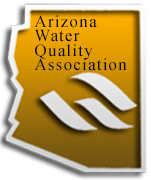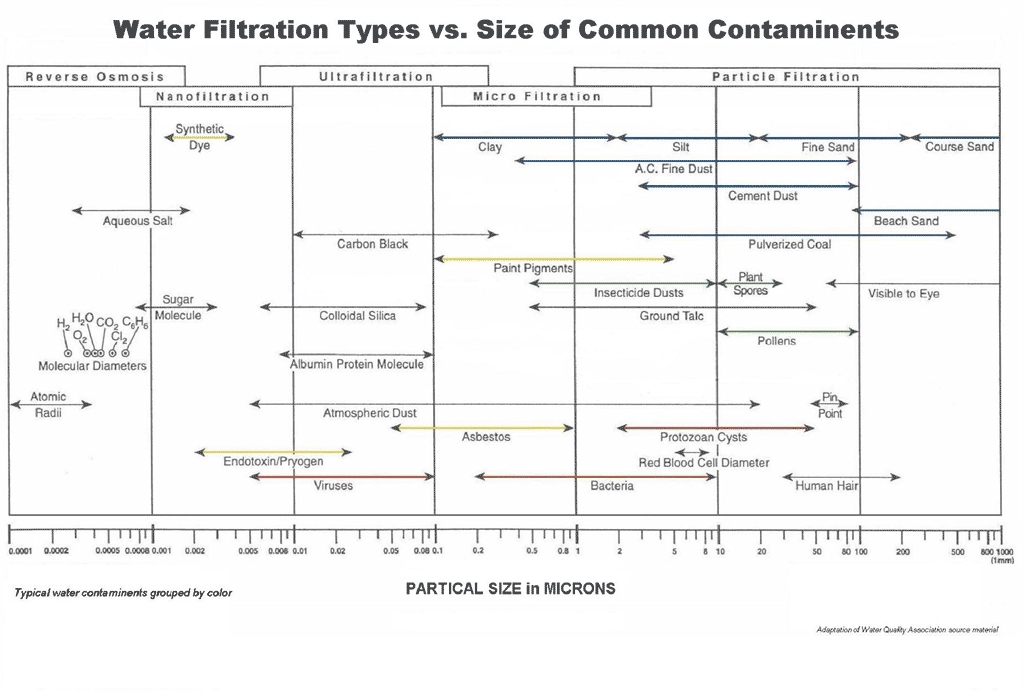Buying Guide
UNDERSTANDING HOME REVERSE OSMOSIS SYSTEMS
What is the Reverse Osmosis (RO) Process?
Reverse Osmosis Systems (RO) : Water pressure is used to force water molecules through a very fine membrane leaving the contaminants behind. Purified water is collected from the “clean” or “permeate” side of the membrane, and water containing the concentrated contaminants is flushed down the drain from the “contaminated” or “concentrate” side. The average RO system is a unit consisting of a sediment/chlorine pre filter, the reverse-osmosis membrane, a storage tank, and an activated-carbon post filter.
Reverse osmosis removes salt and most other inorganic material present in the water, and for that reason, RO lends itself to use in places where the drinking water is brackish (salty), contains nitrates or other dissolved minerals which are difficult to remove by other methods.
Stages of Filtration
The modern RO system is a unit consisting of a sediment pre-filter to remove particulates, turbidity, sand and rust; an activated carbon pre-filter to remove the chlorine, pesticides, herbicides, disinfectants, and VOCs which might otherwise damage the reverse osmosis membrane; the reverse-osmosis membrane which removes virtually everything such as heavy metals, lead, salt, chromium and dissolved solids; a storage tank, and an activated-carbon post filter. The carbon post filter or polishing filter is necessitated by the demineralized, slightly acidic RO water attacking the rubber inside the storage tank, dissolving some of the rubber. This can be avoided by remineralizing the water prior to storage. This remineralization technology is found in the patented Artesian Full Contact system.
- Sediment Stage: removes rough particles, sand and rust.
- Carbon stage: removes chlorine and chemicals which would otherwise damage the TFC reverse osmosis membrane. Multiple carbon stages my be necessary at this point depending on the carbon quality and contact time.
- Reverse osmosis stage: removes dissolved solids nd virtually everything larger than the water molecule itself. This is where the bulk of the purification is accomplished.
- Remineralization Stage: water purified by reverse osmosis is highly pure and slightly acidic. The Tap Master Artesian Full Contact remineralizes with calcium and magnesium to balance the pH, improve the taste and introduce healthy minerals.
- Storage tank
- Optional or application specific water treatment stage(s): UV filter to destroy microorganisms, nitrate/arsenic/fluoride/deionization selective filters to remove whatever small amount remains of these contaminants.
- Final Carbon stage: also known as a “polishing” filter this carbon filter removes any tastes or odors the acidic RO water has “picked up” from the storage tank. In other words the acidic water produced from systems without the Artesian Full Contact technology will dissolve some of the rubber in the storage tank which the final carbon filter then removes.
Reverse Osmosis Purity
Reverse osmosis removes salt and most other dissolved inorganic material present in the water, and for that reason, reverse osmosis water filters are usually used in places where the drinking water is brackish (salty), contains nitrates, radionucliatides, heavy metals or other dissolved minerals which are difficult to remove by other methods. Using a quality carbon filter to remove any organic materials and chemicals that get through the sediment pre-filter, in conjunction with RO produces water with a purity that approaches distilled water is important for any house water filtration system. Microscopic parasites (including viruses) are usually removed by RO units, but any defect or micro-tear in the membrane will allow these organisms to pass into the ‘clean” water. This is why RO systems are not rated to remove microorganisms except when an Ultraviolet Light filter is incorporated into the system, such as in the case of the Tap Master UV and the Tap Master ULTRA.
Reverse Osmosis Efficiency and Waste
Though slower than a water filter, RO systems can typically purify more water per day than distillers. Also, they do not use electricity, but RO systems do waste water. Four or more gallons of concentrated waste water are flushed down the drain for every gallon of filtered water produced. Zero waste RO units are available, however problematic, as they can re-inject the concentrate waste water back into the water feeding the RO thus forcing the RO to work harder and shortening its service life. Other types of Zero Waste RO units will inject the wastewater into the hot water line where it is dispensed out of the kitchen faucet on your hands or dishes. A better option for reducing reverse osmosis system water waste is to fit it with a permeate pump, which will reduce water waste by up to 80%.
Types of Reverse Osmosis Membranes
Two common types of household RO membranes are the Thin Film Composite (TFC or TFM) membrane and the Cellulose Triacetate (CTA) membrane. The main differences between the two types are filtration ability and chlorine tolerance. The CTA membrane is chlorine tolerant, but is more susceptible to fouling from bacteria, and it only rejects 93% of standard contaminants. The TFC/TFM membranes reject 98% of standard contaminants on average, are less susceptible to organic fouling, but it can only treat chlorine free water. Carbon pre-treatment filters must be used with a TFC/TFM membrane when purifying chlorinated municipal water supplies. Brackish water, saline water, and brine water membranes are available for marine, industrial, and municipal desalinization projects.
Before water filter reviews, consult our buying guide to home water filtration systems. Topics on process, stages, purity, efficiency, more. Know before buying.
The Tap Master Reverse Osmosis Systems
The Tap Master premium reverse osmosis systems from Advanced Water Filters can eliminate up to 99% dissolved solids, metals, harmful chemicals and microorganisms from your drinking water, because only the most sophisticated components certified to NSF (national science foundation) standards are included in the design and construction of our products.
The Tap Master Reverse Osmosis System
Areas of Excellence
- Purification: the NSF certified components and Dow Filmtec reverse osmosis membrane work together to remove dissolved solids like heavy metals, nitrates, lead and fluoride; sediment, turbidity, and rust; and chemical contaminants like chlorine, chloramines, pesticides, herbicides and gasoline additives. Additional purification is available with the iron and UV filters , and the permeate pump upgrade. For more information please see the specific product page and the FAQs page.
- Leak elimination: The leading competitors canister type RO system uses the same filter housing year after year, subjecting it to constant high water pressure, water erosion, and wear from maintenance. Only the filter element is replaced. After about 5 years the walls and seals of the competitors canister filter housing begin to weaken and decay, eventually failing, potentially causing a substantial leak.
- User-friendliness: The first thing you will notice about the Tap Master Reverse Osmosis system is that the filters are incorporated into the filter housing, so that when it comes time for the annual filter change, the filter, and the entire filter housing, are disposed of. This is to prevent flooding in your home and make your annual service easier. Just unplug and go – no tools required!
- Efficiency: Tap Master RO system uses high grade filters designed to yield 3900 gallons of purified water, with both carbon stages made from coconut shell activated carbon with filtration down to 5 microns. Compression disks in the Tap Master’s advanced inline filters prevents channeling and dumping and permits an outstanding 10 full inches of carbon contact for greater purification. The competition typically uses lower grade filters made from coal carbon rated to purify just 1500 gallons of water because of the carbon grade and the insufficient carbon contact time made with a thin wall carbon block. The competition also uses recommends multiple filter changes per year in order to compensate for their poor quality filters.
- Reduced waste: In designing the Tap Master RO a sophisticated combination of flow restriction components were integrated into the system architecture to regulate pressure to and from the 50 gallon per day membrane chamber for optimized water purification and minimized wastewater production. For further system efficiency improvement please consider a permeate pump which will reduce wastewater, increase water production, and allow your storage tank to fill fuller.
The first thing you need to know about our reverse osmosis system is that our filters are incorporated into the filter housing, so that when it comes time for the annual filter change, the filter, and the entire filter housing, is disposed of. This is to prevent flooding in your home. The leading competitors “canister” type RO system keeps the same filter housing year after year, subjecting it to constant high water pressure, water erosion, and wear from maintenance. Only the filter element is changed. The manufacturers of these systems recommend you replace the canister housing sump and cap every 5 years because their housings’ walls and seals begin to weaken and decay, eventually failing, potentially causing substantial damage. Advantage – Tap Master!
The second thing you should notice about the Tap Master RO system is the high grade filters designed to yield 3900 gallons of purified water, with both carbon stages made from coconut shell carbon, and filtration down to 5-microns. The competition typically uses lower grade filters made from coal carbon rated to purify just 1500 gallons of water, with one 5-micron filter and one 10-micron filter. The competition also uses extra filter stages and recommends multiple filter changes per year in order to compensate for their poorer quality filters. Advantage – Tap Master!
The “steady” water flow from a typical home RO system will take about 40 seconds to fill a pitcher or large spaghetti pot. This level of performance was unacceptable to the water wizards here Advanced Water Filters, who devised a Fast Flow RO™ kit for the Tap Master which effectively doubles the water flow from your RO sink spigot! We never stop searching for new ways to satisfy.
In designing the Tap Master RO a sophisticated combination of flow restriction components were integrated into the system architecture to regulate pressure to and from the 50 gallon per day membrane chamber for optimized water purification and minimized wastewater production. For further system efficiency improvement please consider a permeate pump which will reduce wastewater, increase production, and allow your tank to fill fuller.
The Tap Master reverse osmosis drinking water purification system is a premium product designed to convert your tap water into pure, delicious drinking water. The advanced membrane used in the Tap Master can safely eliminate up to 98% of dissolved solids, metals, and harmful chemicals from your tap water.
Why Choose Mountain Fresh Water?

In Business since 1979

![]()



"They were on time, very professional and the price was right."
William B., Scottsdale, AZ


